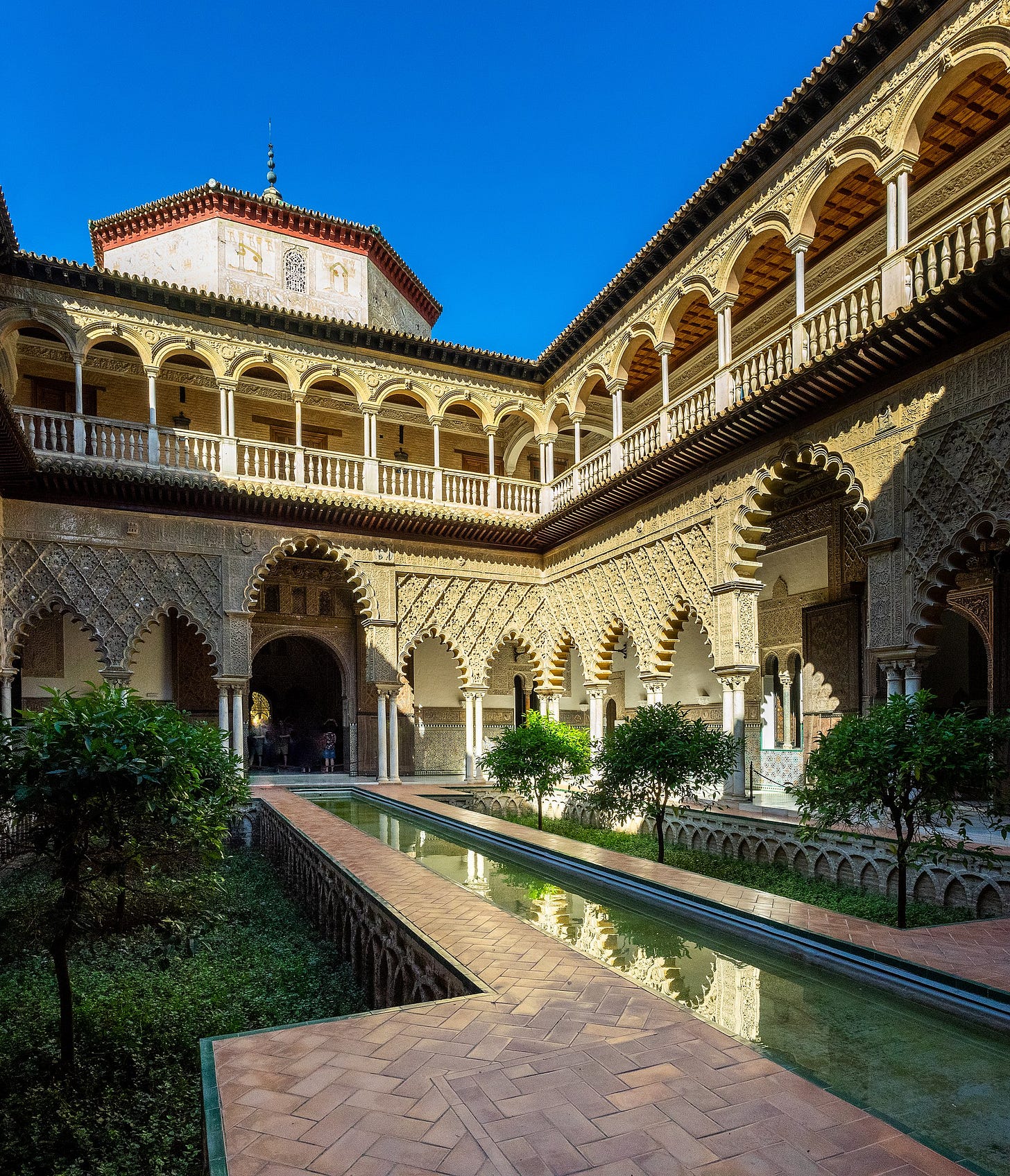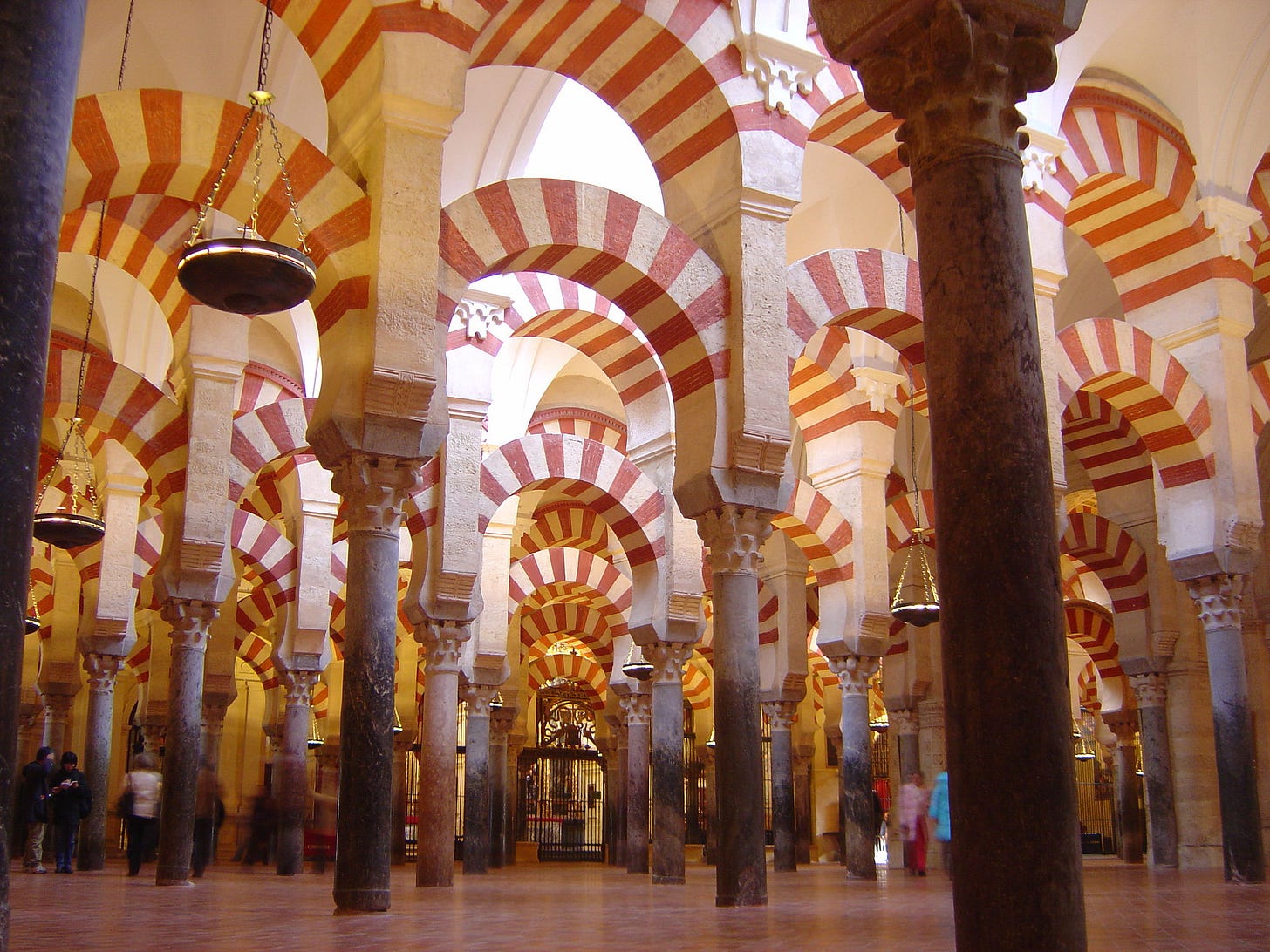Basking in the Beauty of Andalusia: Our Virtual Tour of this Cultural Oasis!
Explore Beautiful Andalusia, Spain with our Epicurean Vagabonds Armchair Tour

For many years we taught a college class called “The Art of Wine.” The purpose of the class was to focus in on a specific region of the world and examine the connections between the wine, cuisine, music, art, literature and culture that all hailed from that unique location. In doing so, we focused in on the role that geography and “terroir” play upon wine, food and artist alike.

With this lens in mind, we’ve curated an exploration of the very rich region of Andalusia just for you! We hope it will offer up a bite-sized taste of what we did in our Art of Wine classes and give you a chance to sit back and travel to another place and time.
Sherry:
Nothing says Andalusia quite like the region’s world-renowned beverage, Sherry (aka Jerez-Xérès-Sherry DOP). We recommend getting your exploration started by purchasing a few bottles of the various styles of sherry to pair with some classic Andalusian dishes.
Here are some recommendations:
Lustau Almacenista Manuel Cuevas Jurado Manzanilla Pasada de Sanlucar Sherry (Purchase here or here): “Pale straw colour, this manzanilla pasada is delightfully aromatic with reminiscences of green apples and the characteristic hint of sea breeze. Dry, fresh and light, yet with a good body and a refreshing acidity.” - Lustau Tasting Notes (from their website)
Williams & Humbert Collection, Amontillado, 12 Year Old Dry Palomino (Purchase here or here): “Elegant and complex nutmeg and prune notes on the palate, rich, spiced dried fruits follow. Concentrated nuttiness, lively acidity and saltiness with persistent finish.” - Gold, International Wine Challenge
Lustau, Almancencista Juan Garcia Jarana, Oloroso “Pata de Gallina” (Purchase here and here): “Dark gold in color, with aromas of dried fruits and pipe tobacco. Very concentrated, with a powerful intensity on the palate and a slightly sweet finish, found in the oldest soleras of Oloroso sherries.” - Lustau Tasting Notes (from their website)
Lustau, Solera Reserva San Emilio, Pedro Ximénez (Purchase here or here): “The aromas are reminiscent of figs, raisins and dates. Serve with rich desserts, cakes and pastries, or pour over vanilla ice cream.” - Lustau Tasting Notes (from their website)
Food:
Here are a few perfect Andalusian foods to pair with your sherry before you dive into some flamenco music, a virtual tour, or the golden age of poetry in Al-Andalus:
Manzanilla Olives & Boquerones en Vinagre (White Anchovies in Vinegar)
Pair with: Lustau Almacenista Manuel Cuevas Jurado Manzanilla Pasada de Sanlucar Sherry

Manzanilla Olives [Steven Walling, CC BY-SA 3.0 via Wikimedia Commons] 
Boquerones en Vinagre (White Anchovies in Vinegar) [Kent Wang, CC BY-SA 2.0 via Wikimedia Commons] Jamón Ibérico (Ibérico Ham)
Pair with: Williams & Humbert Collection, Amontillado, 12 Year Old Dry Palomino

Jamón Ibérico [Valdavia, CC BY-SA 3.0, via Wikimedia Commons] Pair with: Lustau, Almancencista Juan Garcia Jarana, Oloroso “Pata de Gallina”
Pair with: Lustau, Solera Reserva San Emilio, Pedro Ximénez
[For an authentic pestiños recipe, click here!]

Pestiños [Tamorlan, CC BY 3.0 via Wikimedia Commons]
Music:
You will definitely need some Andalusian music while you enjoy your sherry, nibble some olives and white anchovies and Ibérico ham, and start preparing your gazpacho and pestiños!
If you prefer something classical, nothing beats classical pianist Javier Perianes (born in Nerva) playing the works of Andalusia’s most famous composer, Manuel de Falla (born in Cádiz)!
But if you prefer something more upbeat, music to clap your hands and stomp your feet, then now is the moment to hear some flamenco! Start with music by the three great masters of nuevo flamenco — singer Camarón de la Isla and guitarists Paco de Lucía and Tomatito. Or the gorgeous soaring vocals of cantaoras La Paquera de Jerez and Estrella Morente in the cante flamenco style. And for a joyous modern fusion of flamenco with Latin, Afro-Cuban, Moorish and Middle Eastern sounds, check out Son de la Frontera.
Finally, if you’d rather relax to the soothing, spiritual, Sufi-influenced sounds of Arab-Andalusian classical music, check out the albums below by the Amsterdam Andalusian Orchestra, Ensemble Ibn Arabi and Ghada Shbeir.
Classical: Manuel de Falla performed by Javier Perianes
Flamenco: Camarón de la Isla, Paco de Lucía, Tomatito, La Paquera de Jerez, Estrella Morente & Son De La Frontera
Classic Music of Al-Andalus: Amsterdam Andalusian Orchestra, Ensemble Ibn Arabi and Ghada Shbeir
Visual Art:
One of our favorite Andalusian painters is José Cruz Herrera, (born in La Línea de la Concepción), whose stunning portraits perfectly capture the diverse, multicultural faces of Andalusia.
Check out the Art of José Cruz Herrera:
You can also take virtual tours of some of Andalusia’s great museums. Here are three of the best:
Take A Virtual Tour of Museo Carmen Thyssen Málaga (primarily 19th century Spanish painters from Andalusia)
Take A Virtual Tour of Museo de Bellas Artes de Sevilla (Spain’s second largest museum, with a focus on 17th century masters from the Golden Age of Spanish Painting)
Take A Virtual Tour of The Archeological Museum of Seville (from prehistory through the Roman Empire, with an excellent exhibition on the gods and goddesses of ancient Rome)
The Golden Age of Poetry in Al-Andalus:
One of the most fascinating eras of medieval European history is the time when Muslims, Christians, and Jews peacefully co-existed for over seven centuries (711 to 1492) in the geographic area known as Al-Andalus (aka “The Garden”) or Moorish Spain. The Arabic conquest of Spain ignited an early Renaissance and a Golden Age for poets writing in Arabic and Hebrew. The Andalusian poets were the precursors to the troubadours (the word troubadour comes from the Arabic root “tariba”), and these poets took their inspiration from the multicultural and multiracial society in which they lived.
There were poets writing poems in Hebrew using Arabic verse forms, and there were poems known as “jarchas,” many written by women, which included lines in Spanish (the earliest examples of lyrics written in a modern romance language). And the Spanish words are written with Arabic or Hebrew characters! Most of the poems were about wine and love (love involving all combinations of genders, by the way!).
For more information on this fascinating historical period, the following book is a must-read:
The Ornament of the World: How Muslims, Jews, and Christians Created a Culture of Tolerance in Medieval Spain by María Rosa Menocal
Some Notable Poets from the Golden Age:
Wallada bint al-Mustakfi (994 or 1010 – 1091)
• Born in Cordoba, daughter of the Caliph of Cordoba, she inherited his wealth and used it to build a palace and literary hall.
• Intelligent, educated, and outspoken, she wrote poetry, was an accomplished singer, hosted a literary salon, gave lectures, and taught classes in poetry and art. Her salon, lectures, and classes were open to women of all classes, from nobility to slaves.
• She never married and she refused to wear the veil. Not only did she stay uncovered, her tunics were transparent and along the seams she would sew on verses from her own poetry. After she was accused of being a harlot, she wore a tunic with the following verse inscribed on the right side:
“For the sake of Allah!
I deserve nothing less than glory.
I hold my head high
and go my way.”
And inscribed on the left side:
“I will give my cheek
to my lover,
and my kisses
to anyone I choose.”
-
Read more about Wallada here:
Fit for High Positions: The Life of Wallada bint al-Mustakfi (via Medievalists.net)
Listen to a recent album inspired by the poetry of Wallada:
Shmuel HaNagid aka Samuel ibn Naghrillah (993–1056)
• Talmudic scholar, grammarian, philologist, soldier, politician, patron of the arts, and an influential medieval Hebrew poet.
• Born in Merida, he started out as a shopkeeper and opened a spice shop, but gradually rose to prominence. Historians say he was, politically-speaking, the most influential Jew in Muslim Spain.
• Most of his poetry had been lost for centuries, but HaNagid’s oeuvre of nearly 2,000 poems was found by chance in a crate of manuscripts in 1924 and published for the first time in the 1930s.
Ibn ʿArabī (1165–1240)
• Sufi polymath (scholar, mystic, poet, and philosopher) who wrote over 700 works. Considered one of the most influential of all Islamic philosophers and poets.
• Known as “Sultan of the Knowers,” “The Reviver of Religion” and “Doctor Maximum” (“The Greatest Teacher”), he was also considered a saint.
• Believed in a universal view of the validity of all faiths and spiritual traditions, expressing the notion that each person is on their own unique path to finding the truth.
The Greatest Modern Poet/Playwright of Andalusia: Federico García Lorca (1898–1936)
We can’t have a booklist about Andalusia without mentioning the beautiful, surreal, and highly-charged writing of the great Federico García Lorca, whose writing we cannot recommend highly enough! Check out any of his exquisitely-written books below:
Andalusian Architectural Deep Dives:
The following virtual tours take you on a series of visually mind-blowing guided visits to some of Andalusia’s most famous architectural attractions. You could spend hours exploring these sites. It really feels like you’re actually there!
We hope you enjoyed our little slice of Andalusia. Stay tuned for more Epicurean Vagabonds Armchair Tours to come!












YES!!! Believe me, I’m planning on it. I was looking up flights to Rome possibly in early June if that works for you.
Andalusia looks stunning! Another place I must visit! I love these armchair tours. The photos are gorgeous, and you pack them full of fascinating examples of art, history, food and wine! Thank you!